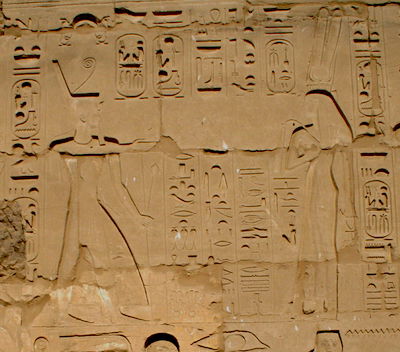Ahmose Nefertari is thought to be the daughter of Queen Ahhotep, sister and wife of King Ahmose I, mother of king Amenhotep I, and the grandmother of Tuthmosis I. She was influential during the reign of her husband and ruled as co-regent with her son Amenhotep I and her grandson Thuthmosis. Tuthmosis I placed her statue in the temple at Karnak to honour her, and her mortuary cult was observed long after her death.

She is almost always depicted with very dark skin. Some commentators have suggested that this is a sign of her Nubian ancestry, which could very well be the case, but it is equally likely that it was a symbol of her fertility and a reference to her position as the mother of Egypt (also known as Kemet, “the black land”), as the colour black was associated with rebirth, fertility, death, and Egypt itself. The god Amun was also depicted with black skin. She generally wears the vulture headdress of Nekhbet.

Ahmose Nefertari was the first queen to hold the important office of “God’s Wife of Amun”, effectively establishing her as the joint head of the priesthood of Amun. Ahmose set up a stele in the temple of Amun at Karnak which functioned as a legal decree establishing not only the office of God’s Wife but endowing it with lands and goods in perpetuity. This was a position of great power given the primacy of the cult of Amun. She made an impressive number of offerings in temples from Karnak to Deir el Bahri, Abydos, and Serabit el Khadim (in the Sinai), suggesting that her role was an active one rather than an empty title.

There is also some evidence that she was involved in the building works of her husband. Her name appears in texts recording the opening of limestone quarries, and is inscribed on the walls of an alabaster quarry near Assiut. Ahmose also recorded that when he made the decision to construct a cenotaph honouring his grandmother Tetisheri, he asked his wife’s approval before starting the building works.
She outlived her husband, and her son (Amenhotep I). Although her son’s successor, Tuthmosis I, was probably not related to her he established a statue of her in the Temple of Karnak. We don’t know when she died. The only reference to her passing is an undated stele fragment which refers to an undated time
“when the God’s Wife Ahmose Nefertari, justified with the Great God, Lord of the West, flew to heaven…”

She was honoured for many centuries as “royal daughter, royal sister, great royal wife, royal mother, great ruler, mistress of both lands”. She (and her son Amenhotep I) were the patrons of the workers village of Deir el Medina and they kept her cult alive well into the New Kingdom. The area Dra Abu el Naga (on the West Bank close to Deir el Bahri) was also closely associated with her (and Ahhotep) and she was the object of worship for many Ramesside tombs, stele, and chapels in the vicinity. It is likely that she was buried in this area, but her tomb and chapel have not been found. Emile Brugsch thought that he had discovered (and unwrapped) her mummy, but this attribution is not secure.
Bibliography
- Bard, Kathryn (2008) An introduction to the Archaeology of Ancient Egypt
- Bryant, Betsy (2000) “The 18th dynasty before the Amarna Period”, in The Oxford History of Ancient Egypt Ed I. Shaw
- Dodson, A and Hilton, D. (2004) The Complete Royal Families of Ancient Egypt
- Kemp, Barry J (1991) Ancient Egypt: Anatomy of a Civilisation
- Rice, Michael (1999) Who’s Who in Ancient Egypt
- Robins, Gae (1993) Women in Ancient Egypt
- Strudwick, Nigel and Helen (1999) Thebes in Egypt
- Tyldesley, Joyce (2006) Chronicle of the Queens of Egypt
- Wilkinson, Toby (2010) The Rise and Fall of Ancient Egypt
- Ziegler, Christine Editor (2008) Queens of Egypt: From Hetepheres to Cleopatra
Copyright J Hill 2010